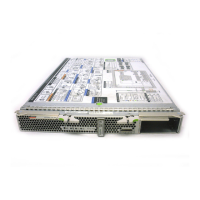86 Netra SPARC T4-1B Server Module Service Manual • June 2012
■ “Verify DIMM Functionality” on page 86
▼ Verify DIMM Functionality
1. Access the Oracle ILOM prompt.
Refer to the SPARC T4 Series Servers Administration Guide for instructions.
2. Use the show faulty command to determine how to clear the fault.
■ If show faulty indicates a POST-detected fault, go to Step 3.
■ If show faulty output displays a UUID, which indicates a host-detected fault,
go to Step 4.
3. Use the set command to enable the DIMM that was disabled by POST.
In most cases, replacement of a faulty DIMM is detected when the SP is power
cycled. In those cases, the fault is automatically cleared from the server module. If
show faulty still displays the fault, the set command will clear it.
4. For a host-detected fault, verify the new DIMM.
a. Set the virtual keyswitch to diag so that POST will run in Service mode.
b. Power cycle the server module host.
Note – Use the show /HOST command to determine when the host has been
powered off. The console will display status=Powered Off. Allow approximately
one minute before typing this command.
-> set /SYS/MB/CMP0/BOB0/CH0/D0 component_state=Enabled
-> set /SYS/keyswitch_state=Diag
Set ‘keyswitch_state’ to ‘Diag’
-> stop /SYS
Are you sure you want to stop /SYS (y/n)? y
Stopping /SYS
-> start /SYS
Are you sure you want to start /SYS (y/n)? y
Starting /SYS

